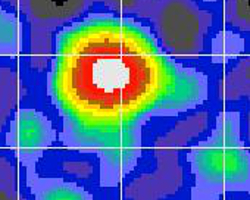 HEAPOW: Catching the First Burst (2018 Aug 20)
HEAPOW: Catching the First Burst (2018 Aug 20)
There was a time when the nature of Gamma-ray bursts (GRBs) was a complete mystery. This was largely because early Gamma-ray observatories had difficulty localizing these bursts in the seconds to minutes before the burst faded. Detection by X-ray, UV and optical telescopes could potentially localize a GRB and identify the source of the emission. But for decades no one knew for sure if GRBs even emitted any lower-energy radiation, and, even if they did, catching the short-lived burst simultaneously with a both Gamma-ray and X-ray telescopes telescopes would require difficult coordination between the two independent observatories. The breakthrough was made by the Italian-Dutch X-ray satellite BeppoSAX. BeppoSAX carried on-board a Gamma-ray burst monitor along with a sophisticated X-ray telescope. On 28 February 1997, a Gamma-ray burst was discovered simultaneously by the BeppoSAX Gamma Ray Burst Monitor and its Wide Field X-ray Cameras by a team of Italian/Dutch scientists at the Scientific Operations Center in Nuova Telespazio, Rome. The Italian scientists responsible for the Gamma-ray burst detector onboard the satellite, quickly working with the Mission Scientist and the Mission Director, were able to reschedule the satellite observations. In only 8 hours, the operations team was able to point the high-esolution X-ray telescopes (the Low Energy Concentrator Spectrometer and the Medium Energy Concentrator Spectrometer) at the Gamma-ray burst. As a result, an unknown X-ray source, in the constellation of Orion, was discovered and localized. A second follow-up was performed with narrow field instruments after about 2 days. This second observation showed that the source faded by about a actor of 20, confirming that this transient X-ray source and the transient Gamma-ray source were one and the same. The BeppoSAX X-ray images taken during the two follow-up observations are shown in the figure above. These X-ray observations, and subsequent observations in the radio and optical, revealed that this Gamma-ray burst source came from a star-forming galaxy and showed, for the first time, that Gamma-ray bursts were extremely powerful explosions from beyond the Milky Way.
HEAPOW: X-ray Afterglow of a Gamma-Ray Burst: The Grail Found?
BeppoSAX: Follow-up Observations of GRB 970228
| << Previous HEAPOW | High Energy Astrophysics Picture of the Week | Next HEAPOW >> |